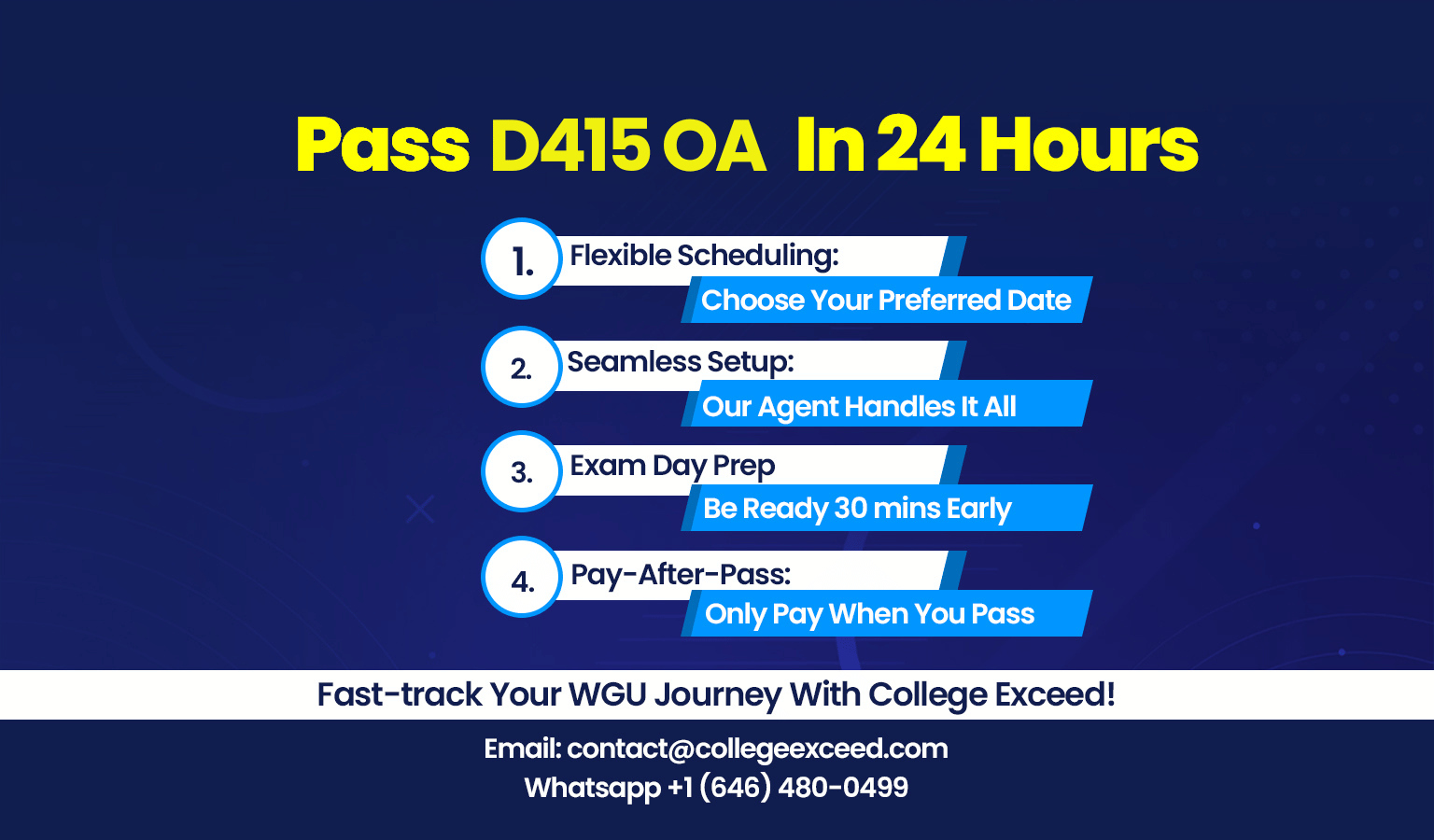Welcome to your ultimate guide on passing the Software Defined Networking WGU D415 course at WGU! It’s okay if you currently have the ‘itchy feet syndrome’ about leaping into this class or any other class for that matter. For many learners SDN is a very tough area but with the right attitude, you can overcome it and do well on the OA (Objective Assessment).
Well, in this article, we will take you through all the basic information that you will require in order to succeed in WGU D415. Let’s begin with the general description of the module, together with the main materials and topics that will be an essential concern of the test. Then, for your convenience, we will offer you a week-by-week study schedule that will guide you throughout your learning process. In addition, some of the external sources will be presented, and there will be an overview of the topics important for this course and answers to the questions that students often have. At the end of this guide, you will be confident enough to face the OA and nail that passing mark. Let’s get started!
...
Exploring WGU D415 Software Defined Networking: What to Expect📖
SDN is a fast-growing area of interest in network engineering and WGU D415 is specially designed to give students a good mastery of this revolutionary technology. When you launch into this module, you will understand the nature of the SDN paradigm with a focus on networking automation, the use of intent-based networking, and centralized control of networks. These concepts are elementary to current-day networking and are gaining substantial prominence as organizations transform their network architecture to dynamic novel approaches.
During the course, you will be taken from the conventional isolated device-centric network management to a more systematized automated overall approach. This is a shift that is very important as it defines, optimizes, and centralizes the management of the network resources. Once you get a good grasp of SDN, you should be in a good position to control and possibly automate the network in a way that was only a dream with conventional techniques.
Prepare to probe areas like network automation; it is a process of eliminating manual network configuration by creating scripts and coordination for such. You will learn about intent-based networking which means actual networking can be coded in terms of business intent where the distributed system automatically codes the systems. Also, the aspect of centralized network control will be underscored, thereby enabling you to learn how to control the entire network from a central control instead of controlling devices one by one.
These topics are not only fundamental to passing the OA but also vital for any aspiring network engineer looking to stay ahead in the field. The OA will heavily test your understanding of these concepts, so be sure to pay close attention to the material and seek to apply what you learn in practical scenarios. With this foundation, you’ll be well on your way to mastering the SDN paradigm
Study Guide for WGU D415 OA : Software Defined Networking📝
To succeed in Software Defined Networking D415, it’s important to approach your studies with a clear, organized plan. Here’s a week-by-week breakdown to help you stay on track and make the most of your study time. Following this guide will ensure you cover all essential materials and enter the OA feeling confident.
Week 1: Read the Textbook and Take Section Quizzes
Your first step should be to dive into the course material. Begin by thoroughly reading the textbook, which covers all the core concepts of SDN. As you go through each section, take the quizzes provided to test your understanding. These quizzes are a great way to reinforce what you’ve learned and identify areas where you might need more review.
Don’t miss the three introductory videos that are part of the course. These videos provide a helpful overview and set the stage for deeper learning. Additionally, be sure to explore the SDN notes available in Course Chatter. These notes can offer valuable insights and clarify complex topics.
Week 2: Peruse the Supplemental Material
In the second week, it’s time to go beyond the textbook and explore additional resources. Start by reviewing the links provided in the “External Resources” section of this guide. These resources offer various perspectives and deeper dives into certain SDN topics, which can enhance your understanding.
One highly recommended resource is the OpenStack course available on WGU Udemy: OpenStack. This course provides practical insights into SDN and helps bridge the gap between theoretical knowledge and real-world application. Completing this supplemental material will give you a more rounded understanding of SDN and its applications.
Week 3: Do the Pre-A
Getting into the 3rd week means it is time to evaluate whether one is ready for the OA by taking the Pre-A. The Pre-A is helpful as it is an imitation of the actual exam and as a result, one gets to determine a strength and areas of weakness. Approach it as a real one—take it in a silent room and do it within the specified time frame.
After completing the Pre-A, review the results carefully. Focus on any questions you missed and revisit the corresponding sections in the textbook or supplemental materials. This targeted review will help solidify your knowledge and prepare you for the final exam.
Week 4: Do the OA
In the last week of the practical part, you must sit for the OA. After this stage, students should be familiar with what is taught in a course and feel capable of passing. Try to be well-rested for the exam and try to have a positive attitude toward the exam. Do not rush your decisions – remember, the OA is your best shot at demonstrating all you’ve amassed in terms of knowledge throughout the course.
This study plan is designed to ensure you cover all necessary materials and enter the OA well-prepared. Stick to it, and you’ll be on your way to successfully passing WGU D415.
...
Top Resources for D415 Software Defined Networking 📂
Quizlet Flashcards
∙ WGU Software Defined Networking D415 Flashcards: This set of flashcards covers key terms and concepts, making it an excellent tool for quick review sessions.
- D415 Software Defined Networking Flashcards: Another great set of flashcards to test your knowledge. These can be particularly useful when you’re preparing for the Pre-A and OA.
∙ SDN YouTube Playlist
∙ SDN YouTube Playlist: This playlist includes a set of videos on fundamental SDN notions explained in an easy and comprehensible way. These videos can be useful for revising after reading the text in the textbook, and watching the video may help find a different perspective on the material and, thus, a better understanding of the topic.
∙ SDN Made Simple – Udemy Course
∙ SDN Made Simple: This is a Udemy course designed to help the beginner get a very basic understanding of what SDN is. It is a paid course however sometimes they have offers on the price and the course is worth paying for if you require a more in-depth understanding of the certain subject.
∙ SDN Course on CBT Nuggets
∙ Understand Software-Defined Networking Architectures: In this course on CBT Nuggets focusing on software-defined networking as a discipline, there is much attention paid to its architectures. Although it is paid, it is widely popular among students and is known to be helpful if a person is trying to go beyond the basics of machine learning.
...
WGU D415 OA Tips for Success in Software Defined Networking👨🏻🏫
Preparing for the Software Defined Networking D415 OA requires not just understanding the material but also strategizing how you approach the exam. Here’s some advice on how to maximize your chances of success, based on insights from students who have taken the exam and performed well.
Understand the Complexity of the PA and OA
The first thing you need to know is that the Pre-Assessment (PA) and the Objective Assessment (OA) are quite aligned in terms of complexity and the types of questions you’ll encounter. This means that if you can do well on the PA, you’re likely in good shape for the OA. However, don’t take this as a sign to relax. Use the PA as a diagnostic tool to identify any weak areas where you need further review. Focus on understanding the reasoning behind the “reasonable” answers in the PA. The OA will often present you with two reasonable and two unreasonable answers per question, so being able to distinguish between them is crucial.
Master the Terminology
In particular, terminology is a focus of this course. It is advisable that you familiarize yourself with many acronyms and technical terms you are likely to encounter, thus do not neglect this factor. Especially NFV (Network Function Virtualization), VNF (Virtualized Network Function), VNFM (Virtual Network Function Manager), VNFI (Virtual Network Function Infrastructure), and CVSS (Common Vulnerability Scoring System). These terms are not only incorporated in the questions but also offered in the general theme of the subjects tested in the exam.
If you are not therefore familiar with some of the basic network security principles such as, if you have not taken a CCNA or if you do not have much experience working with firewalls, then spend some time revisiting these areas. The OA prescribes the use of certain elements of networking; especially the OSI model layers 1 through three; so you need to have a good grasp of these before progressing.
Focus on Specific Topics
Certain topics are emphasized more heavily on the OA, so it’s important to know where to focus your efforts. You’ll likely encounter multiple questions on OpenStack, the differences between SDN vs. NFV, and the specifics of NIST 800-53 and NIST 800-125B. Understanding these frameworks and standards will give you an edge. Additionally, be sure to review the differences between Southbound vs. Northbound interfaces—a topic that can be confusing but is crucial for understanding SDN architecture.
Network security is another area where you’ll want to be particularly sharp. Expect questions related to IDS/IPS (Intrusion Detection System/Intrusion Prevention System), firewalls, and other security-related topics. Even if these aren’t your strongest areas, make sure you have a basic understanding, as these questions can be the difference between passing and failing.
Leverage External Resources
While the course materials are essential, don’t forget to supplement your study with external resources. Watching videos on platforms like Pluralsight and Udemy can provide additional explanations and examples that may clarify difficult concepts. Focus especially on videos that cover the acronyms and security basics mentioned earlier. Additionally, reviewing what Open Platform and open source mean in the context of SDN will help you tackle related questions with confidence.
Lastly, don’t underestimate the value of using Google to fill in gaps in your understanding. For example, the NIST standards—NIST 800-125B and NIST 800-53—weren’t deeply covered in the course material, but a quick search can provide you with the insights you need to understand these standards more fully.
Final Thoughts
In summary, preparation for the OA in Software Defined Networking D415 involves a combination of mastering terminology, understanding key topics, and leveraging external resources to fill in any knowledge gaps. By focusing on the areas outlined here and making sure you’re comfortable with the reasonable answers in the PA, you’ll be well-prepared to tackle the OA with confidence.
...
Frequently Asked Questions: D415 Software Defined Networking❓
- What are the key topics for the OA?
Focus on SDN vs. NFV, Northbound vs. Southbound interfaces, and network security concepts like NIST 800-53, IDS/IPS, and firewalls. Know the acronyms like NFV, VNF, and CVSS.
- How similar is the OA to the PA?
The OA and PA are very similar in difficulty and question format. If you do well on the PA, you should be well-prepared for the OA.
- Do I need prior networking knowledge?
Yes, basic networking knowledge, especially on OSI layers 1-3 and network security, is important. Brush up on these if you’re not familiar.
- What external resources should I use?
Use Pluralsight and Udemy for videos, Quizlet for flashcards, and explore topics like OpenStack and NIST standards.
- What if I struggle with network security?
Focus on the basics of firewalls and IDS/IPS. Use external videos and resources to clarify difficult concepts.
...
Conclusion: Navigating Software Defined Networking📄
The Software Defined Networking D415 course at WGU is a fun and intense look into one of the most rapidly expanding fields of network engineering. Planned study, concentration on the concepts, and involvement of other resources will help you sail through this course and clear the OA.
Remember, preparation is key. As to practice, the PA shall be used to define one’s strong and weak traits and ensure that the rationale for the beneficial answer has been understood. First of all, be careful with the acronyms and the terminology, as they are the basis of both the course and the OA. However, the right approach is that apart from passing the exam, you stand to gain knowledge that will help you in your line of duty.
You are welcome to come back to this guide as you build up your study timetable for the Software Defined Networking D415 OA. You’ve got this!






